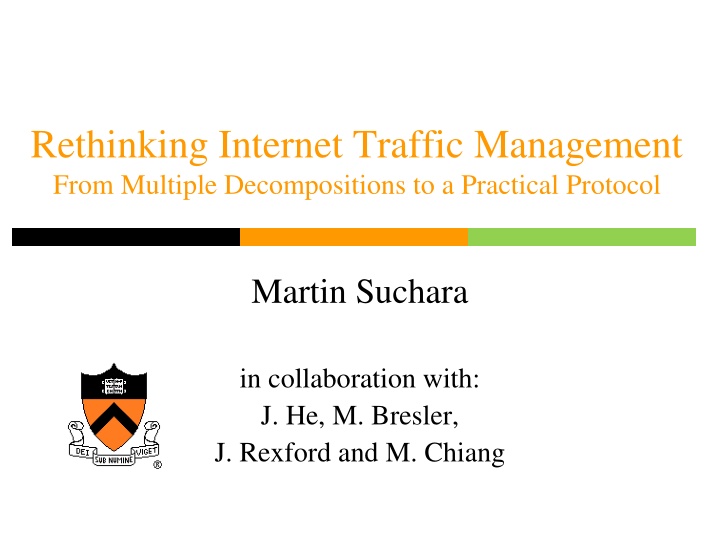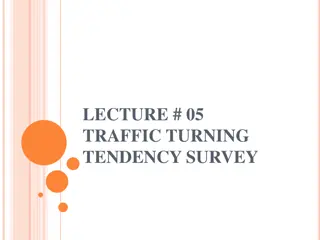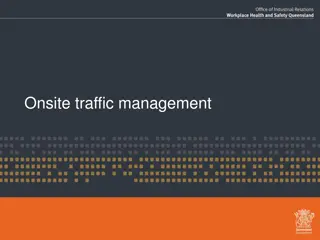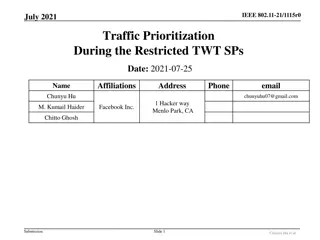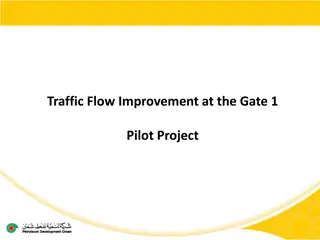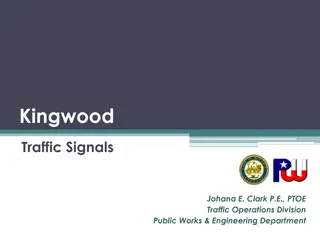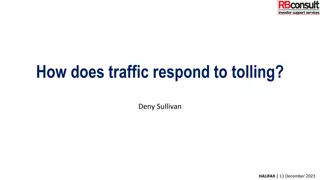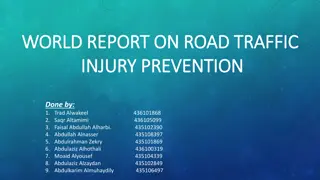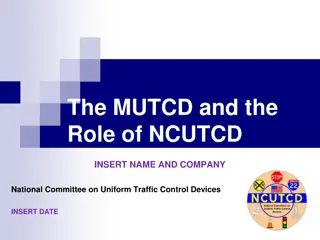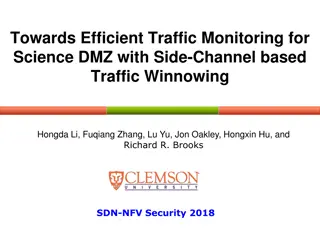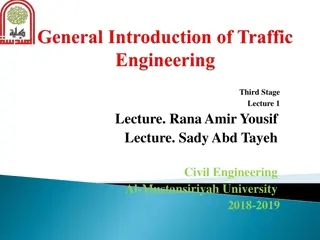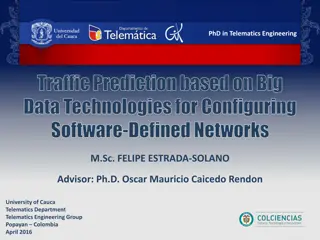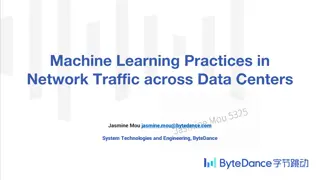Rethinking Internet Traffic Management for Enhanced Efficiency
Traffic management in networks is crucial for optimizing resource allocation, congestion control, and routing. This discussion highlights the shortcomings of current systems and proposes a novel protocol for more effective traffic management. The approach involves optimization theory, simulation evaluations, and a top-down redesign process to address issues like suboptimal interactions and inefficiencies in traffic engineering.
Download Presentation

Please find below an Image/Link to download the presentation.
The content on the website is provided AS IS for your information and personal use only. It may not be sold, licensed, or shared on other websites without obtaining consent from the author.If you encounter any issues during the download, it is possible that the publisher has removed the file from their server.
You are allowed to download the files provided on this website for personal or commercial use, subject to the condition that they are used lawfully. All files are the property of their respective owners.
The content on the website is provided AS IS for your information and personal use only. It may not be sold, licensed, or shared on other websites without obtaining consent from the author.
E N D
Presentation Transcript
Rethinking Internet Traffic Management From Multiple Decompositions to a Practical Protocol Martin Suchara in collaboration with: J. He, M. Bresler, J. Rexford and M. Chiang
Why Study Traffic Management? Traffic management is important Determines traffic rates and divides resources Integrates routing, congestion control, traffic engineering, important The architecture has shortcomings Suboptimal interactions of components shortcomings Motivated by recent advancements in optimization theory research 2
Traffic Management Today Operator: Traffic Engineering Evolved organically without conscious design Routers: Routing Protocols User: Congestion Control 3
Shortcomings of Todays Architecture Protocol interactions ignored Congestion control assumes routing is fixed TE assumes the traffic is inelastic Inefficiency of traffic engineering Link-weight tuning problem is NP-hard TE at the timescale of hours or days What would a clean-slate redesign look like? 4
Contributions of This Talk 1. Case study of a design process Based on optimization decompositions Evaluations using simulation also needed 2. The new design Of network traffic management The next steps: Towards virtualized networks 5
Top-down Redesign Problem Formulation Optimization decomposition Distributed Solutions Compare using simulations TRUMP Algorithm Translate into packet version TRUMP Protocol 6
Congestion Control Implicitly Maximizes Aggregate User Utility Source-destination pair indexed by i aggregate utility User utility Ui(xi) max. i Ui(xi) s.t. i Rlixi cl var. x Fair rate allocation amongst greedy users routing matrix Source rate xi source rate Utility represents user satisfaction and elasticity of traffic 7
Traffic Engineering Explicitly Minimizes Network Congestion Links are indexed by l aggregate congestion cost Cost f(ul) min. l f(ul) s.t. ul= i Rlixi /cl var. R ul =1 Avoids bottlenecks in the network Link Utilization ul link utilization Cost function is a penalty for approaching capacity 8
A Balanced Objective max. i Ui(xi) - w l f(ul) Penalty weight Network users: Maximize throughput Generate bottlenecks Network operators: Minimize delay Avoid bottlenecks 9
Top-down Redesign Problem Formulation Optimization decomposition Distributed Solutions Compare using simulations TRUMP Algorithm Translate into packet version TRUMP Protocol 10 Optimization decomposition requires convexity
Convex Problems are Easier to Solve Non-convex Convex Convex problems have a global minimum Distributed solutions that converge to global minima can be derived using decompositions 11
How to Make our Problem Convex? Single path routing is non convex Multipath routing + flexible splitting is convex max. i Ui( j zji) w l f(ul) s.t. link load cl var.path ratesz 11 isource-destination pair,jpath number 5 10 6 6 z11 1 4 9 9 z21 2 8 3 z31 7 12 Path rate captures source rates and routing
Overview of Distributed Solutions Operator: Tune w, U, f Other parameters s s s Routers: Set up multiple paths Measure link load Update link prices s Edge node: Update path rates z Rate limit incoming traffic 13
Role of Optimization Decompositions Derive price and path rate updates Prices: penalties for violating a constraint Path rates: updates driven by penalties Example: TCP congestion control Link prices: level of packet loss or delay Source rates: adjust window based on prices Our problem is more complicated More complex objective, multiple paths 14
Key Principles I: Effective Capacity Rewrite capacity constraint: link load= yl effective capacity yl cl link load cl Effective capacity yl Dynamically updated Advance warning of impending congestion Simulates the link running at lower capacity and give feedback on that Effective capacity keeps system robust 15
Key Principles II: Consistency Price and Subgradient Updates Consistency price pl Relax constraint yl cl but penalize violation with price pl Allow packet loss to converge faster Subgradient feedback price update: pl(t+1) = [pl(t) stepsize*(cl yl (t))]+ Stepsize controls the granularity of reaction Stepsize is a tunable parameter 16
Four Decompositions Differences Differ in how link & source variables are updated Algorithm Features Partial-dual Effective capacity Primal-dual Effective capacity Full-dual Effective capacity, Allows packet loss Primal-driven Direct price update Parameters 1 3 2 1 Iterative updates contain stepsizes: They affect the dynamics of the distributed algorithms 17
Top-down Redesign Problem Formulation Optimization decomposition Distributed Solutions Compare using simulations TRUMP Algorithm Translate into packet version Final Protocol 18 Optimization doesn t answer all the questions
Evaluating Four Decompositions Theoretical results and limitations: All proven to converge to global optimum for well-chosen parameters No guidance for choosing parameters Only loose bounds for rate of convergence Sweep large parameter space in MATLAB Effect of won convergence Compare rate of convergence Compare sensitivity of parameters 19
Simple Topologies Used in MATLAB 4 5 3 6 2 11 1 5 1 10 4 6 2 9 8 3 20 7
Effect of Penalty Weight w Topology dependent User utility w Operator penalty Can achieve high aggregate utility for a range of w 21
Convergence Properties: Partial Dual in Access Core Topology average value x actual values Parameter sensitivity Best convergence 22 Tunable parameters impact convergence time
Convergence Properties (MATLAB) Parameter sensitivity correlated to rate of convergence Algorithms Convergence Properties All Partial-dual vs. Primal-dual Partial-dual vs. Full-dual Partial-dual vs. Primal-driven Converges slower for small w Extra parameters do not improve convergence Allowing some packet loss may improve convergence Direct updates converge faster than iterative updates 23
TRUMP: TRaffic-management Using Multipath Protocol Insights from simulations: Have as few tunable parameters as possible Use direct update when possible Allow some packet loss Cherry-pick different parts of previous algorithms to construct TRUMP One tunable parameter 24
TRUMP Algorithm Linkl: losspl(t+1) = [pl(t) + stepsize*(link load -cl)]+ queuing delay ql(t+1) = wf (ul) Price for pathj = l on path j(pl+ql) Sourcei: Path rate zji(t+1) = max. (Ui( kzki) zji *path price) 25
TRUMP Versus Other Algorithms TRUMP is not another decomposition We can prove convergence, but only under more restrictive conditions From MATLAB: Faster rate of convergence Easy to tune parameter 26
Top-down Redesign Problem Formulation Optimization decomposition Distributed Solutions Compare using simulations TRUMP Algorithm Translate into packet version TRUMP Protocol So far, assumed fluid model, constant feedback delay, greedy traffic sources 27
TRUMP: Packet-based Version Linkl: link load = (bytes in period T) / (clT) Update link prices every T Arrivals and departures of flows are reflected in price changes Sourcei: Update path rates at maxj {RTTji} 28
Packet-level Experiments in NS-2 Set-up: Synthetic topologies + realistic topologies and delays of large ISPs Multiple paths with 1ms to 400ms of delay Realistic ON-OFF traffic model Questions: Do MATLAB results still hold? Does TRUMP react quickly to link dynamics? Can it handle ON-OFF flows? Number of paths needed? 29
TRUMP Versus Partial Dual in Sprint TRUMP Partial dual Aggregate throughput stabilizes for a range of w s No stepsize allows satisfactory convergence TRUMP trumps partial dual for w 1/3 30
TRUMP Link Dynamics Link connecting NJ and IN in the Sprint network fails and recovers 31 TRUMP reacts quickly to link dynamics
TRUMP Versus File Size Worse for smaller files but still faster than TCP 32 TRUMP s performance is independent of variance
TRUMP: A Few Paths Suffice Diminishing returns when providing more than 2 paths Worse for smaller files but still faster than TCP 33 Sources benefit the most when they learn a few paths
Summary of TRUMP Properties Property Tuning Parameters TRUMP One easy to tune parameter Only needs to be tuned for small w Robustness to link dynamics Reacts quickly to link failures and recoveries Robustness to flow dynamics Independent of variance of file sizes, more efficient for larger files General Trumps other algorithms 34
Division of Functionality Today TRUMP Operators Tune link weights Set penalty function Sources Adapt source rates Routers Shortest path routing Compute prices Set-up multipath Tune w & stepsize Adapt path rates Sources: end hosts or edge routers? Feedback: implicit or explicit? Mathematics leaves open architecture questions 35
The Next Steps So far the utility function maximizes utility of throughput sensitive traffic However, not all traffic throughput sensitive: 36
The Next Steps: Virtualization Need to support multiple types of applications Throughput-sensitive: file transfers Delay-sensitive: VoIP and gaming Questions What should the utility for each application look like? How to share network resources dynamically? 37
Conclusions Traffic engineering Started with multiple decompositions Designed TRUMP: new traffic- management protocol What to do next? Support of different traffic classes 38
Thank You! 39
Related Work Advancements in optimization theory Protocol reverse engineering (Kelly98, Low03) Design of new protocols (Low06) Multiple decompositions (Chiang06) Traffic management protocols consider congestion control or traffic engineering Congestion control alone (FAST TCP, RCP, XCP, etc.) Use of multiple paths without adjusting source rates (MATE, REPLEX, etc.) 40
